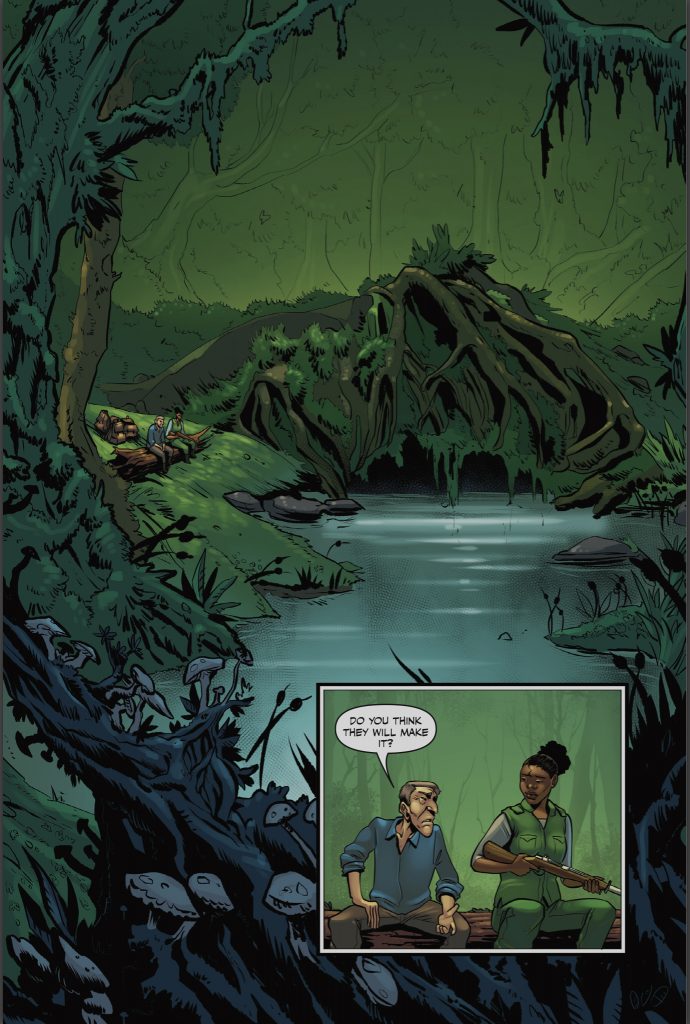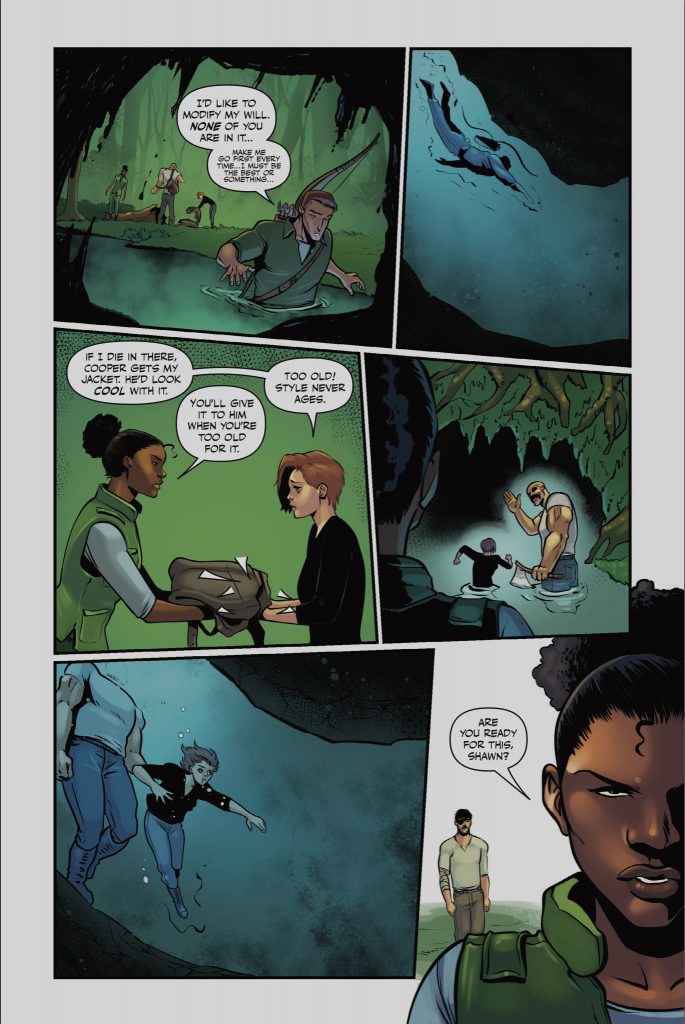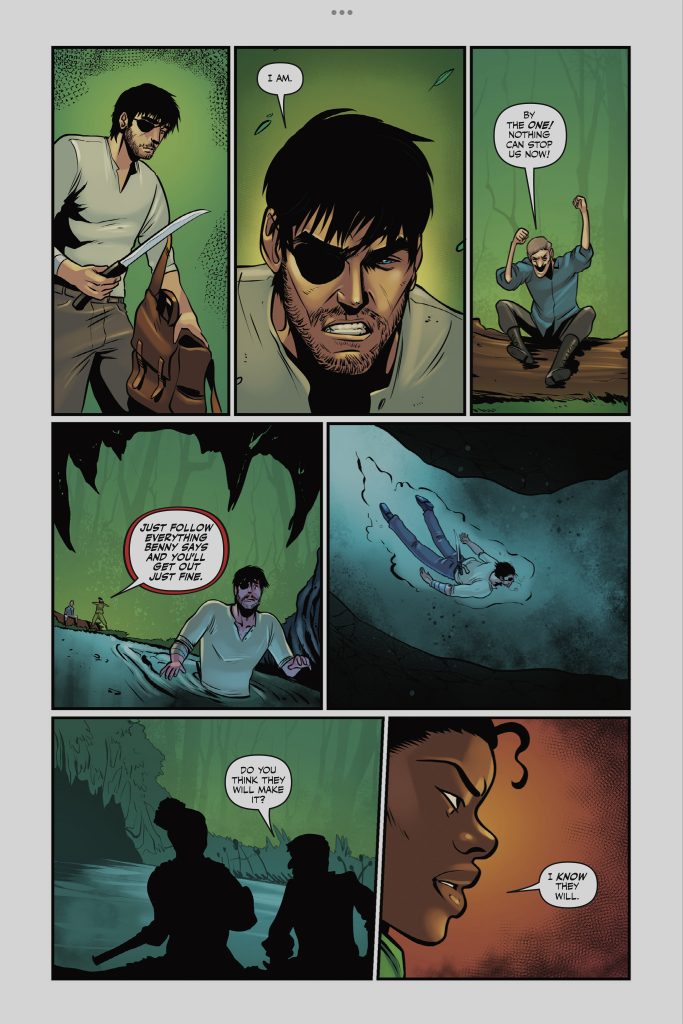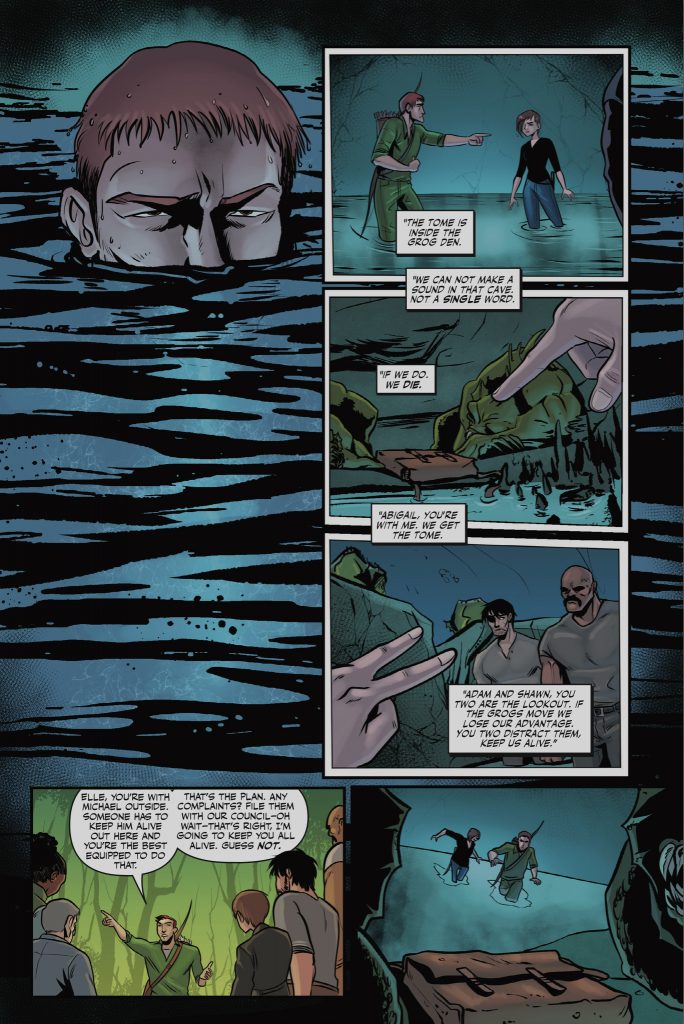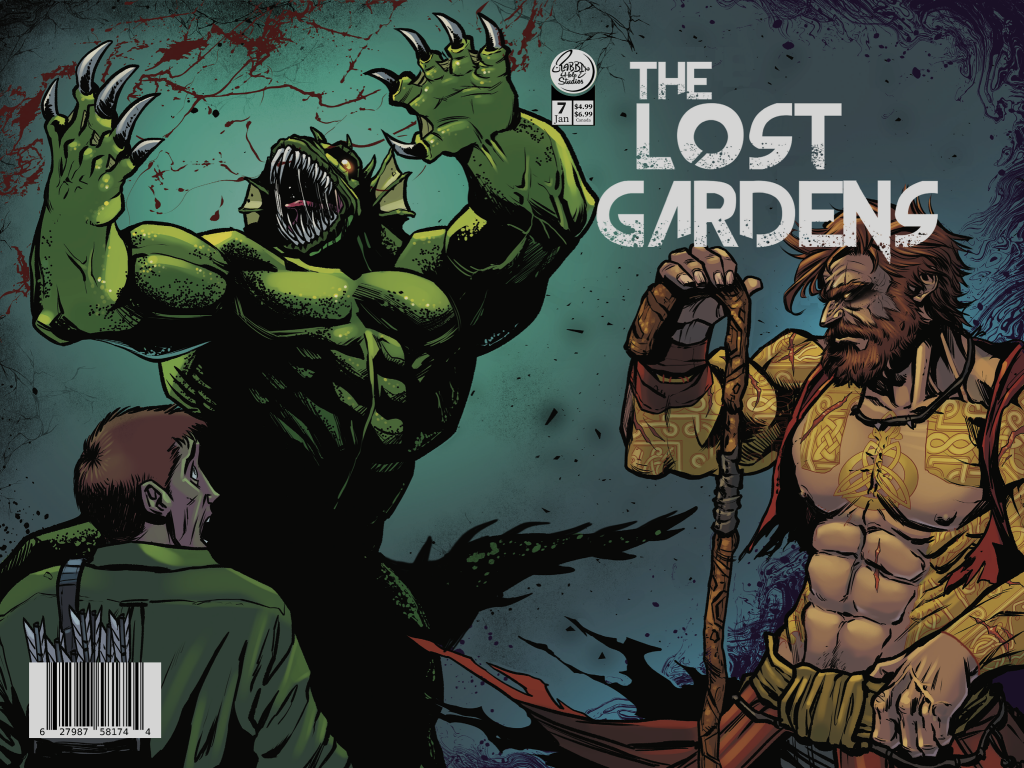
- The Lost Gardens #7
- Rabbit Hole Studios
- Written by James Babineau
- Illustrated by Debora Lancianese
- Colors by Michael Woods
- Letters by Robin Jones
- 1-6 Available in…
- Digital for the Kindle (issues 1-7)
The Lost Gardens follows the life of Shawn Myers, a meek employee of the Ministry of Parts. Set in a world that indulges in a false luxury brought to you by the Etheon Corporation. Shawn’s life begins to unravel as his own technology implants turn defective, spiraling him downward by economic and by a supernatural entity calling itself Fear. Running from his crumbling life, Shawn finds a long-forgotten society abandoned by Etheon long ago, and a new beginning. Lying to keep his origins safe, Shawn gets thrust into an adventure searching for a relic from an ancient text. Will Shawn be able to rise to the occasion or will the entity called Fear consume and use Shawn for its nefarious means?
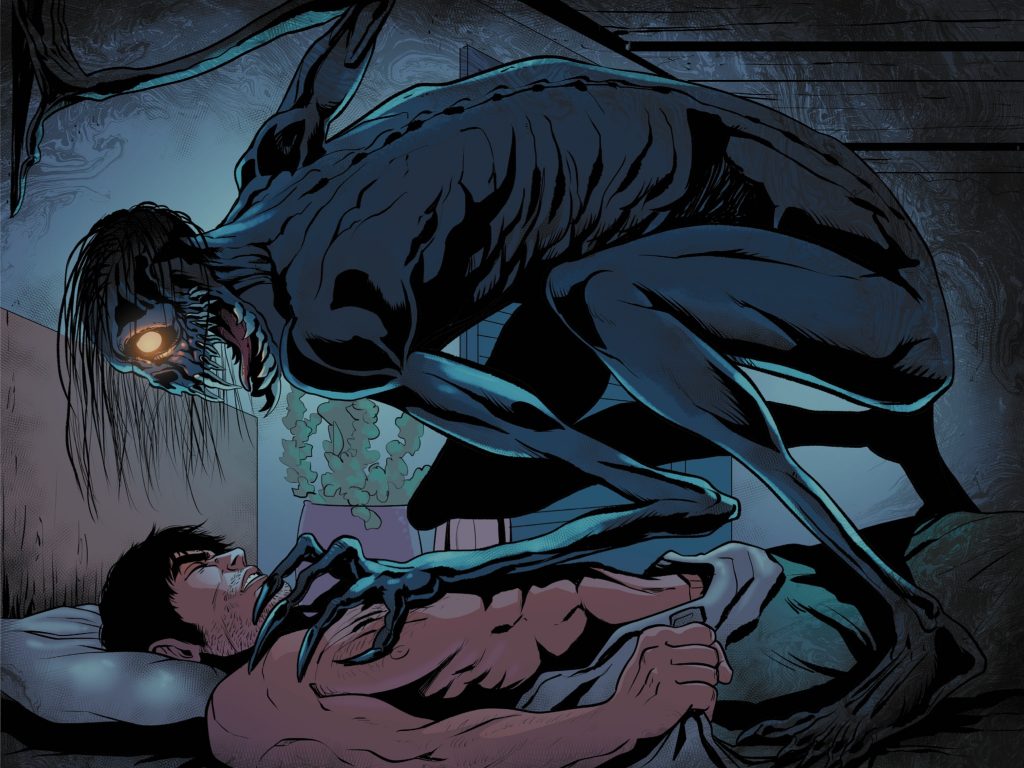
The Lost Gardens is a high concept story that had me changing my perception of it all the way through, issue one to seven. Like The Matrix, people live in a computer-generated world. But here the virtual is replaced by an augmented reality controlled by the all-powerful corporate entity (a staple in any good cyberpunk) Etheon. The world itself is real, but there’s a digital veil overlaying it, showing the people only what Etheon wants them to see.
Shawn Myers, an unassuming cog in a high-tech machine, is on the path to discovering the truth behind the electronic illusion everyone sees through their implants. His regulated world falls apart, first when he loses his job- ironically as a service rep who has to deal with complaints regarding failing technology- due to malfunctions in his own corneal implants, and again when he embraces his new reality in an effort to find something “real”. His spiral takes him out of the city, into a dangerous wilderness that’s been lost & forgotten to the general public.
Speaking as a reviewer who gets more than a few creators submitting their work directly to me, playing catch up on a series is a mixed bag. On the one hand, having to catch up can take a minute and I always end up feeling bad… like I’m making someone wait to find out that their newborn is healthy. On the other hand, it’s kinda cool to be able to follow along from early issues to latest as the creative team digs in and hits its stride. There’s the progression as writers & artists tweak their respective techniques, and the smaller jumps forward as they find something new about a given character to sink their teeth into.
In the case of The Lost Gardens, both of those benefits came into play as I read through the first seven issues. From the start, the illustrations for this title have been outstanding, with Caius Schereiner handling the art for issue one, & Debora Lancianese taking over for two through seven. It’s especially noteworthy considering the series runs the gamut of genre, starting in a science fiction dystopia and then rolling right into more of a wilderness fantasy setting. As most of that shift takes place over later issues, I have to offer Lancianese all the kudos for keeping up with the tonal shifts. All that’s awesome, but I’m not gonna lie… I’m a sucker for a well plotted & choreographed action scene. And lemme tell ya, Debora Lancianese can put together a well plotted & choreographed action scene! Depending on what’s going on and who’s involved, motion either flows smoothly through the panel, or crashes down in a total chaotic mess. Beautiful violence fleshed out and given depth by Michael Woods’s colors.
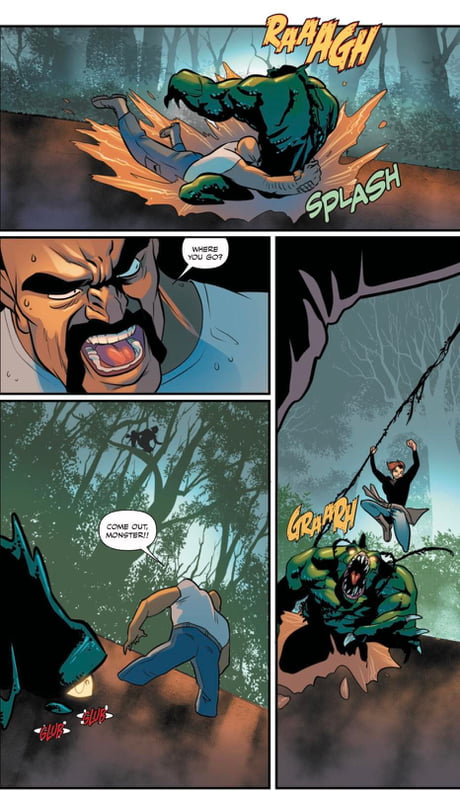
It surprises me when people believe that a colorist just has to worry about staying inside the lines. I mean, Woods does that too, but the job is a lot more involved. A page of fully inked line work can come across in totally different ways, depending on the colorist and their understanding of what writer & illustrator have in mind. In the case of The Lost Gardens, Woods uses a classically “comicbook” palette to fill out the world, but his work shines when you look at the contrasting environments. Earlier issues follow Shawn Myers through the shiny, high tech setting where everything is clean and tidy on the surface. Later, when Shawn’s corneal implants start to fail, and he sees what the world really is, Woods follows that shift as his color scheme turns drab and kinda gross. Later still, when the story takes Shawn from the stark city into the wilderness surrounding the people of Charlotte, Woods keeps pace again as he fills in the lush landscape.
Last but not least on this creative team, writer James Babineau has taken on a complex story about questioning paradigms (great word, right?) and whether living outside of a lie is preferable to the comfort those lies represent. I’ve mentioned the extreme (and abrupt) tonal shifts in the story as the reader follows Shawn from his safe but completely false life to the uncertainty felt when the truth behind the lie is revealed. Then Shawn must adjust to the intense danger of life outside of the influence of the Etheon Corporation. As Shawn deals with the constant influx of new information (and rampaging monsters), his arc keeps the reader as off balance as he is. Reading through the story so far, I had my share of double takes as Shawn goes from meek office worker to badass survivalist at the turn of a page. Babineau challenged my suspension of disbelief over the course of these changes, but I get the idea that there’s still something coming to make sense of it all. Sure, a hint or clue dropped now and again might help a reader reconcile the changes, mental & physical that Shawn goes through, but that’s not the story Babineau is telling. Seven issues in, and I’m now starting to get the idea that there may be a supernatural element lurking in the shadows (the entity called “Fear” in the story synopsis above). Yet another tonal shift in the setting, a storytelling lane change without a signal.
Overall, The Lost Gardens is an entertaining read, full of flips and twists. An impatient reader might be put off by the lack of clues as to the actual direction the story’s taking, but there’s still plenty in there to hang onto if you care enough to see it through. I can’t shake the impression that there is something deeper, a layer that hasn’t been revealed after seven issues. If you do decide to tackle this one, hang in there.
Final Score: 10/13
